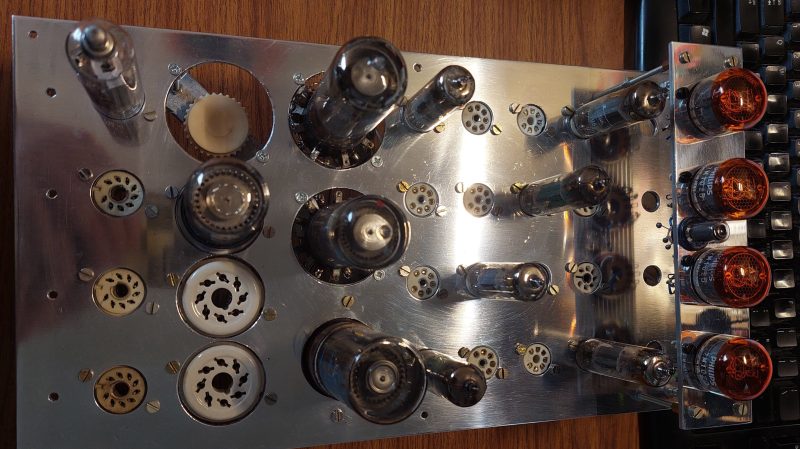Just about every electronic device has some silicon semiconductors inside these days—from transistors to diodes to integrated circuits. [Charles] is trying to build a “No-Silicon digital clock” that used none of these parts. It looks like [Charles] is on the way to success, but one might like to point out an amusing technicality. Let’s dive in to the clock!
Instead of silicon semiconductors, [Charles] is attempting to build a digital clock using valves (aka tubes). More specifically, his design relies on seven dekatrons, which are the basic counting elements of the clock. By supplying the right voltages to the various cathodes of the dekatrons, they can be made to step through ten (or sometimes twelve) stable states, used as simple memory elements which can be used as the basis for a timepiece. [Charles] will set up the first dekatron to divide down mains frequency by 5 or 6 to get down to 10 Hz, depending on whether the supply is 50 Hz or 60 Hz. The next dekatron will step down 10 times to 1 Hz, to measure seconds. The next two will divide by ten and six to count minutes, while a further two will divide the same way to create an impulse per hour. A final dekatron will divide by 12 to count the hours in a day.
Naturally, time will be displayed on Nixies. While silicon semiconductors are verboten, [Charles] is also considering the use of some germanium parts to keep the total tube count down when it comes to supporting hardware. Also, [Charles] may wish to avoid silicon, but here’s the thing about tubes. They use glass housings, and glass is made of silicon.
Cheeky technicalities aside, it’s a great project that promises to create a very interesting clock indeed. Progress is already steaming along and we can’t wait to see the finished product. We’ve seen dekatrons put to good use before, too. If you’re cooking up your own practical projects with mid-century hardware, don’t hesitate to let us know!
















Now that’s a proper project. What goes in that empty hole with what looks like a tea candle in the bottom?
Could claim “no semiconductors” instead of no silicon if you used the original namesake of diodes (or maybe some neons?) but that would add to the difficulty and complexity quite a bit
I have a supply of 6CW4 Nuvistor triodes. Miniature and robust without that verboten glass enclosure.
“but here’s the thing about tubes. They use glass housings, and glass is made of silicon. ”
The silicon in the tubes is not monocrystalline, and not [purposefully] doped, so I think we’re good.
A smart person would point out that glass is not made of silicon. Glass, like beach sand is made of silicon dioxide. This is basic “inhale, exhale, wipe” stuff. Your family will miss you later but sweeping ineptitude under the carpet keeps them busy for now.
it’s also not conducting any electricity.
The silicon in the envelope of an electronic vacuum valve is no more like elemental silicon than elemental chlorine is like the salt it forms with sodium.
ok, but now do it like https://hackaday.com/2016/05/30/hackaday-prize-entries-inventing-new-logic-families/ and use ONLY the diodes :P
I think its funny how many people are perturbed by the joke about being silicon free yet there is glass. Mostly because if the author didn’t write it, I would bet 10 NE555’s someone would have left it as a snark comment :D. Cool project I really enjoy when people constrain their projects for fun.
This guy needs to review The Clock Of The Long Now. And then consider the Year 10000 problem.
He could have made it a whole lot simpler by going analog.
Here’s how: you build an integrator that adds up every positive half-cycle of the AC waveform. Doing so, you get a voltage that ramps up in discrete steps with each AC cycle.
Then you find the voltage level of the N-th step and use a comparator circuit to reset the integrator when it reaches the N-th step. That’s how you do frequency division in analog.
So you could in theory do a single step divide by 50/60 on the line frequency and call it a day.
Or just build a synchronous motor and use suitable gear ratios to get the time!
Germanium transistors (and diodes) to the rescue!